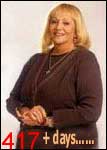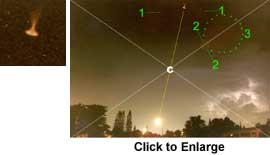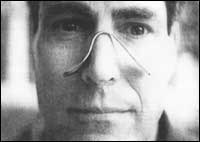
 Reader Justin Smith looked for the source of Sylvia Browne's year-2000 predictions that I'd posted here for readers' comments. He reports that they used to be posted by Sylvia, at http://www.sylvia.org/home/predictions.cfm, but they've suddenly been removed! He wondered why...
Reader Justin Smith looked for the source of Sylvia Browne's year-2000 predictions that I'd posted here for readers' comments. He reports that they used to be posted by Sylvia, at http://www.sylvia.org/home/predictions.cfm, but they've suddenly been removed! He wondered why...
But, says this tireless researcher,
What is cool, is that there is a "Wayback Machine," a big archive of webpage content of the past at http://web.archive.org/collections/web.html, so I entered in www.sylvia.org, and checked on the most recent Jan 23 2002 entry and navigated my way to: http://web.archive.org/web/20020124115018/www.sylvia.org/home/predictions.cfm. Oh look, there are her predictions for the year 2000!
You'd think Sylvia would have known....!
Readers' decisions on the accuracy of Ms. Browne's predictions for 2000 have been highly varied, from zero on up....
 I was sent this photo by a puzzled reader who felt that he'd probably — unknowingly — captured the image of a UFO while snapping a spectacular display of lightning during one of Florida's frequent storms. You see that artifact here, very near the top and slightly to the right, the entire frame being shown.
I was sent this photo by a puzzled reader who felt that he'd probably — unknowingly — captured the image of a UFO while snapping a spectacular display of lightning during one of Florida's frequent storms. You see that artifact here, very near the top and slightly to the right, the entire frame being shown.
Now, we've handled this sort of matter before on this web site, notably at www.randi.org/jr/04-04-2000.html Yes, this is another simple lens flare, seen in close-up in the second illustration. These are often interpreted as UFOs by the unwary. In the third illustration, "C" marks the center of the optical field, and you will see that the faint circles registered on the film (#s 1 and 2 are between the marks indicated, #3 is delineated by green dots) are centered on that spot.  The "UFO" shape is an internal lens reflection (flare) caused by the strong street-light in the frame. Circles 1, 2, and 3, are similar internal reflections. No mystery at all.
The "UFO" shape is an internal lens reflection (flare) caused by the strong street-light in the frame. Circles 1, 2, and 3, are similar internal reflections. No mystery at all.
The lightning display that was the original target of the photographer, is seen at the lower right. Now, that's something worth pursuing! Nature at work.....
Reader Phil Karn, examining the outstanding in-depth analysis made by Shawn Bishop and offered at http://www.sfu.ca/~sbishopa/soapbox/soapbox_june_02.htm, concludes that the "MEG" device for which the US Patent Office granted a patent to "inventor" Tom Bearden, and which we discussed at length here in recent months, can be summed up for us thus:
So what we really have here is nothing more than an ordinary transformer. In the pictures you see, it's taking power from an external power supply, stepping it up in voltage, and driving a fluorescent lamp — all at an efficiency of less than 100%. The only reason Naudin thought otherwise was because he made a sloppy measurement mistake. And judging from his evasive replies to your questions, it's obvious that he has NOT been able to drive the device's input from its output without having to use the external power supply. That's the acid test that no free energy machine has ever been able to meet.
Concerning the actual source of error in the validating tests, which he points out succinctly, Phil says:
This is about as close to a smoking gun as you're ever likely to find in the world of free energy cranks. I can't wait to see their explanation for this one. Wanna bet they'll blame it on those pesky Drude Electrons interacting with the quantum electro-dynamical flux from the space-time vacuum energy continuum...?
Yes, that would seem to be about what we might expect. But when Naudin, Bearden, and the rest tried this and it didn't work, didn't that bring a clear message through to them? Perhaps the message was that if they could get (a) a patent, and (b) an endorsement from a "scientist," they could sell stock.....?
We're waiting for Naudin or Bearden to write and tell us that they now recognize that the MEG doesn't work. Tune up another bunch of those hard-working crickets.....
After pointing out how he, as a responsible researcher, checks and re-checks his equipment and operational procedures before coming to a conclusion and making any official report, Shawn Bishop commented to Phil:
. . . . as a professional scientist, it is an insult to me to have people like Bearden and Naudin thwart the scientific method, scientific responsibility and scientific honesty by promoting this fakery of physics in the face of such glaringly gross experimental errors. As a global citizen, aware of the growing need to find alternative energy sources for our growing economies and populations, and the threat we all face from global climate change and environmental degradation as a result of our traditional energy sources, that these scam artists would try to defraud the public and investors with such nonsense and scientific fakeries leaves me feeling nothing short of contempt for Naudin and Bearden.
Randi comments: But you know, one assumed quality of scientists — that they will reverse themselves upon recognizing an error — is very often — most often — lacking. In my experience, a scientist will prefer to just hope that a bad notion, decision, statement, conclusion, or theory, will just go away quietly. John Taylor, in the UK, I think quite clearly recognized in the '80s that a spoon-bender and numerous juvenile imitators had hornswoggled him back in the '70s. Yet in his book, "Science and the Supernatural" (Dutton, 1980), he tried to extricate himself from earlier firm declarations of conviction and wonder, and he almost managed to say that he had been deceived, though not quite. That's exceptional. In my opinion, Dr. Gary Schwartz, of the University of Arizona, just might realize someday, not only that he was deceived by clever performers, but that he himself fell into his errors carelessly, willingly, and eagerly. Such scientists never reverse themselves. I include Ted Bastin, John Hasted, and many others in this naive assembly. Sir Arthur Conan Doyle, though not technically a scientist per se, shines in this group.
While on the subject of Schwartz, I'd like to offer this analogy of what that scientist thinks science is all about. Schwartz never tires of telling us how well-educated he is (Harvard, no less!) but that doesn't say anything about how smart he is. As Richard Wiseman points out in the current Skeptical Inquirer (Nov/Dec 2002), Schwartz admits (as if he had any choice!) that there were sources of sensory leakage in his tests of John Edward (see http://www.randi.org/jr/03-23-2001.html) yet he is still convinced that Edward is the "real thing." The basic question here, is why Schwartz allowed the possibility of sensory leakage and judging artifacts to be there at all? The principle of isolation of the subject and the "medium" is rather simple, not expensive nor difficult to implement, and simply must be an element in such experiments!
 My analogy: suppose that Schwartz were not only an experienced sailor, but a shipwright — one who designs and builds boats. He invites us to the beach, where we see that a fine-looking boat of his design and construction is about to be launched for the first time. We and the media are assured that Schwartz obtained his training in his specialty at a leading school where such matters are taught. We're appropriately impressed. We admire the appearance, the paint job, and the general "cut of his jib." The boat looks just fine.
My analogy: suppose that Schwartz were not only an experienced sailor, but a shipwright — one who designs and builds boats. He invites us to the beach, where we see that a fine-looking boat of his design and construction is about to be launched for the first time. We and the media are assured that Schwartz obtained his training in his specialty at a leading school where such matters are taught. We're appropriately impressed. We admire the appearance, the paint job, and the general "cut of his jib." The boat looks just fine.
Schwartz invites folks aboard. The launch takes place, and the craft sails smoothly out into the water. We cheer in appreciation. The media people snap photos, then they quickly depart to report this happy news: that Captain Gary Schwartz has designed, built, and successfully launched his boat. The captain is exuberant, smiling, and satisfied.
But then the boat is seen to be listing to one side. The passengers begin leaping off and swimming to shore as a definite settling in the water becomes evident. The boat, it turns out, is not seaworthy. It settles to the bottom. Captain Schwartz admits that there were some leaky spots that he didn't quite seal up, but the basic design, he says, is sound, and very soon he'll build another that will be properly sealed. He points out the fine appearance of the boat, but offers no reasons why he didn't have it water-tight before launching it. However, it's evident that he's ahead, because a few hours later the newspapers — who weren't informed of the leaks and subsequent sinking — run photos and glowing accounts of the launching. Captain Schwartz receives further support, even from his disappointed colleagues — because he's very well educated, and he's confident that when he gets around to sealing those leaks, the next boat will be just fine.
This simple soul asks, "WHY WAS THE FIRST BOAT, WITH ITS KNOWN FLAWS, BUILT AND LAUNCHED? SURELY HOLES IN A BOAT SHOULD BE PATCHED BEFORE LAUNCHING?" To the uncharitable, it might appear as if Captain Schwartz was in a rush and only wanted the media coverage he got.... And yes, it would appear that the captain should admit his poor construction without urging, but if no one makes a fuss — or if no one cares — he'll continue as a captain and he'll still think he can build boats....
Even I, with my inferior education, know that a leaky boat is a useless boat.
Now, Bearden and Naudin are hardly "scientists," and are certainly not of the quality and talent as those real scientists mentioned here. No one is waiting for them to make a reversal, or to withdraw their claims, or much cares. It would be nice, and an honorable thing to do, but if real scientists don't do it, why should they....?
The real problem here is the dupes who will be taken in, and may invest their money and their emotional security in the scam.
Reader Nels Lindquist suggests that Uri Geller may soon be offered a job in Croatia! That country's top football team, Dinamo Zagreb, has said through their coach, Miroslav Blazevic, that they need someone to become part of the team and be its spiritual guide. "This club is full of demons and they must be chased away," he told a newspaper reporter. The Zagreb Archbishopric, the Kaptol, has announced that on behalf of the team, they're "looking for a suitable person for this demanding job, someone who would have some knowledge of other religions as well, because of the non-Catholic players in Dinamo." Now, there might be some conflict here, because Geller (formerly a paid Reading booster) is now firmly on the side of the UK Exeter Club. In fact, he manages them, but his lack of success (see ahead) might have him looking for yet another club upon which he can bestow his blessing. Dinamo will next be playing English side Fulham in the second round of the UEFA Cup, so Mr. Geller wouldn't have far to go. Well, though Exeter isn't doing very well, and Reading fired Geller long ago, we know that football fans are very forgiving. Not.
 The present status of Exeter? Desperate! They're now third from the bottom of League Division 3, and bottom of the 3rd is the pits. If they don't haul themselves at least one place higher, John Atkinson tells me, they'll drop out of the League altogether and be replaced by another team. Next week they play Darlington, and if they don't win, things will look really black for them. Has Geller run out of crystals or something, or won't they let him dig up the pitch? You see, Geller says that to help certain teams win, he'd secretly snuck out onto the field and buried crystals there. It didn't work, but it still
seems like cheating, to me.
The present status of Exeter? Desperate! They're now third from the bottom of League Division 3, and bottom of the 3rd is the pits. If they don't haul themselves at least one place higher, John Atkinson tells me, they'll drop out of the League altogether and be replaced by another team. Next week they play Darlington, and if they don't win, things will look really black for them. Has Geller run out of crystals or something, or won't they let him dig up the pitch? You see, Geller says that to help certain teams win, he'd secretly snuck out onto the field and buried crystals there. It didn't work, but it still
seems like cheating, to me.
Geller's team presently has won 3, drawn 3, and lost 8. Stay tuned, as we follow the career of this great psychic in the role of professional football manager/advisor/guru/spell-caster!
I came upon this hilarious cartoon of Mr. Geller from February, 1995, in an ad for an appearance with Sir David Frost on a UK TV show, "Beyond Belief!" Frost, as usual, was goggle-eyed, ooohing and aaahing at bending spoons and other Geller specialties; he's always been an easy mark.
 But the photo that really takes the prize and carries a message, is this one from USA TODAY. How Geller could allow such a silly picture to be set up, shot, and published, is hard to understand. But the article itself quotes Geller saying that he is now "over materialism" and wants to sell his pillared UK mansion and live in a French-made solar-powered wooden hut that looks like a space-ship. That scenario may give us a more accurate view of how serious the article really is.
But the photo that really takes the prize and carries a message, is this one from USA TODAY. How Geller could allow such a silly picture to be set up, shot, and published, is hard to understand. But the article itself quotes Geller saying that he is now "over materialism" and wants to sell his pillared UK mansion and live in a French-made solar-powered wooden hut that looks like a space-ship. That scenario may give us a more accurate view of how serious the article really is.
Still on the subject of the spoon-bender, reader Les Waas writes to tell me:
We [Randi and I] met years ago as guests on To Tell the Truth. I am president of the Procrastinators Club of America, and you are, I understand, a member, although you are a bit too active for our tastes. (We might expel you one of these days). . . . Once when (your friend) Uri Geller appeared on the Mike Douglas Show (when I was also a guest) he offered to get non-functioning timepieces working again. Viewers needed simply to place their watches and clocks in front of their TV screens, and presto!, he'd get them going. After the show, one of the cameramen, a friend, asked if I believed that stuff. I gave him reasons why I didn't, but his argument was much simpler: "Today's show was taped," he said. "Geller was fixing watches and clocks that wouldn't be placed in front of TV screens for another 5 weeks!"
Just what I've pointed out for years now. Such obvious facts don't seem to deter the true believers, however. Scores of TV shows with Geller were taped well in advance, and many were repeated — via tape. But the True Believers, undaunted, explain away what would appear to us to be a major problem. You see, they say, these wondrous powers work regardless of separation in time and space. Is it clear now?
Reader Michael I. Sølvstad, from Denmark, informs us:
But what I really wanted to tell you about, is what happened today on live TV. There's a Danish talk show called "Line's," very much like "Oprah," with a rather respected host. But she's turned a bit to "the dark side" lately. Anyway, today's topic was about the explosion of supernatural thinking. She of course had some "Sylvia" clones there, a medical doctor who could read minds, and a few celebrities, and of course only one sceptic. (The Randi clone!)Halfway through the show, the biggest Sylvia clone was told to hold in her palm a ring belonging to a celebrity, and then to tell the audience who the celebrity is when they returned from commercial. After the commercial, the Sylvia clone told us that the celebrity is an actress, a writer, divorced, and so on. But she chickened out when the host asked for a name. Then, the second before they revealed the celebrity, the Randi clone attacked! He asked if he could make a guess, and he said the name.... It was exactly that celebrity!
(At this point I jumped up and down, and yelled "Yes, yes, yes!")
The Sylvia clone was defeated, because the Randi clone had much better "powers"! Later the Randi clone explained that he had checked the TV networks homepage before coming to the talk show, and right there in the TV-listings was the name of the celebrity, though it didn't say anything about the test. The name was just listed to get a bigger audience or whatever.
I was so excited I had to write you! Just wanted to mention the name of your Danish clone. His name is "Michael Leslie Ahlstrand", and also a magician.
Well, I'm very familiar with Michael's work, and I know he's been involved in this field for many, many years now. I think it's time that I visited Denmark again for a series of lectures, and long chats with Michael....
And I must report that, strangely, the Danish doctor that can read minds hasn't applied for our million-dollar prize. My visit to Denmark would be an ideal opportunity, don't you think?
 Reader Ben Hutchings sends us this cartoon for our use and amusement....
Reader Ben Hutchings sends us this cartoon for our use and amusement....
Reader Brian Rush sends us this article from the New York Post:
MOTHER TERESA MIRACLE A HOAX, SAYS VATICAN-BASHING HUBBYIs a Mother Teresa-inspired miracle that's been recognized by the Vatican a complete and utter fraud? Absolutely, says the husband of a woman whose purported tumor vanished after she applied a medallion of the beloved nun to the site of her pain. "My wife was cured by the doctors and not by any miracle," Seiku Besra told Time magazine.
His wife, Monica, claimed to be cured on Sept. 5, 1998, the first anniversary of Mother Teresa's death. Two weeks ago, the Vatican recognized the 1998 miracle, beginning the process toward Teresa's possible sainthood. But Besra, who lives in the Indian town of Dangram — 460 miles northeast of Calcutta — said the Vatican is all wrong in his wife's case. "My wife did feel less pain one night when she used the locket, but her pain had been coming and going," he told the mag. "Then she went to the doctors, and they cured her. This miracle is a hoax."
The two physicians who treated Monica agree. "She responded to our treatment steadily," Dr. Ranjan Mustafi said.
As Brian points out, the husband is designed as, "Vatican-bashing." How about, "truthful," or "honest." No, that would be far too factual....
TIME Magazine had more details on the matter:
Monica's medical records contain sonograms, prescriptions and physicians' notes that could conceivably help prove whether science or the icon worked the cure. But the records are missing. Monica says Sister Betta of the Missionaries of Charity took them away two years ago. "It's all with her," says Monica. A call to Sister Betta, who has been reassigned to another post of the Charity, produced a "no comment." Balurghat Hospital officials say the Catholic order has been pressuring them to say that Monica's cure was miraculous. Calls to the office of Sister Nirmala, Mother Teresa's successor as head of the order, produced no comment as well.
 Just how much of this "saint" nonsense do we have to have derailed, before the train comes to a halt? Bernadette's face is made of wax, Padre Pio the Masochist is elevated, the proposed Mexican saint, peasant Juan Diego, now looks like a total fiction, and various moldering corpses within the Vatican itself are proving the lie, every day. But mythology, promoted by an organization that must have a constant input of the pennies of the poor, needs more and more saints.....
Just how much of this "saint" nonsense do we have to have derailed, before the train comes to a halt? Bernadette's face is made of wax, Padre Pio the Masochist is elevated, the proposed Mexican saint, peasant Juan Diego, now looks like a total fiction, and various moldering corpses within the Vatican itself are proving the lie, every day. But mythology, promoted by an organization that must have a constant input of the pennies of the poor, needs more and more saints.....
I was visiting recently with a rare book collector, and in his collection of references, old and new, I found a number of definitions of the subject, "astrology." It's interesting to see how the opinions on this nonsense have changed over the years....
Judiciary, or Judicial Astrology, which is what we commonly call Astrology, is that which pretends to foretell moral Events; i.e. such as have a Dependance on the Will and Agency of Man; as if that were directed by the Stars. . . . The same Superstition has prevailed in more modern Ages and Nations.
- Chambers Cyclopedia, 1728The practice of foretelling things by the knowledge of the stars; an art now generally exploded, as without reason.
- Samuel Johnson's Dictionary of the English Language, 1755A conjectural science, which teaches to judge of the effects and influences of the stars, and to fortel future events by the situation and different aspects of the heavenly bodies. This science has long ago become a just subject of contempt and ridicule.
- Encyclopaedia Britannica, 1771.A science which teaches to judge of the effects and influences of the stars, and to foretell future events, by their situation and different aspects. This science was formerly in great request, as men ignorantly supposed the heavenly bodies to have a ruling influence over the physical and moral world; but now it is universally exploded by true science and philosophy.
- Webster's Dictionary, 1828The so-called science by which various nations, in various ways, have attempted to assign to the heavens a moral influence over the earth and its inhabitants. . . It is no longer necessary to protest against an error which is dead and buried . . .
- New Americanized Encyclopedia Britannica, 1896Judicial astrology, as a form of divination, is a concomitant of natural astrology, in its purer astronomical aspect, but mingled with what is now considered an unscientific and superstitious view of world-forces.
- Encyclopaedia Britannica, 1945The practice of interpreting the influence of planets and stars on earthly affairs in order to predict or affect the destinies of individuals, groups, or nations. At times regarded as a science, . . . astrology has also been defined as a pseudoscience and considered to be diametrically opposed to the theories and findings of modern science.
- Encyclopaedia Britannica, 1987The study that assumes and attempts to interpret the influence of the heavenly bodies on human affairs.
- Random House Webster's College Dictionary, 1999The study of how the positions of stars and planets supposedly affect people's lives.
- Scholastic Children's Dictionary, 2000
Note in these definitions the use of the words: assumes, contempt, dead and buried, error, exploded, pretends, pseudoscience, ridicule, so-called, superstition, supposedly, and unscientific, in describing the subject.....
In all declarations on the subject by advocates we find the firm convictions that (a) the Earth is at the center of the universe, and that (b) our species, Homo sapiens, is the center of all attention, purpose, natural forces, and existence. There's an old philosophical question, "If a tree falls in the forest, and there's no one there to hear it, does it make a sound?" This question would never arise if there were not a strong feeling that we humans are, to borrow from Shakespeare's Macbeth, the "be-all and the end-all" — and then some.
In Sir Arthur Conan Doyle's quite silly-yet-serious book "The Coming of the Fairies" (1920) he expressed this homocentric notion clearly. Referring to the fairies who he believed lived in the woods, he wrote:
These creatures are in any case remote from us, and their existence is of little more real importance than that of strange animals or plants. At the same time, the perennial mystery why so many "flowers are born to blush unseen," and why Nature should be so lavish with gifts which human beings cannot use, would be solved if we understood that there were other orders of being which used the same earth and shared its blessings. It is at the lowest an interesting speculation which gives an added charm to the silence of the woods and the wilderness of the moorland.
To Sir Arthur, it was a genuine puzzle why flowers would bloom if they were not to be seen by humans, and he was quite serious about his suggestion, above. I'm sure that his answer to the falling-tree-in-the-forest question would have been a confident, no. Unless, of course, some of the wee folk chanced to be flitting nearby.
This bizarre homocentric idea has brought about much grief, misunderstanding, prejudice, and misinformation. Astrology is just one product of the idea, one that should have been laughed out of existence long ago, but hangs around like an unwanted visitor whose back we dearly want to see as he becomes smaller on the horizon....
Reader Cameron Raecke writes:
I found an amusing site recently that claims to be able to guess one's gender by asking personality-related questions. A friend and I both took the test, and it did indeed accurately predict our respective sexes.
Just a note: it sounds as if Cameron and friend had not yet been assigned genders! I think he meant to write "ascertain" rather than "predict"?
The interesting thing about this site was that each time a person takes a test, those data are entered into the program's sex-prediction algorithm, the idea being that it becomes more accurate as more people take the test. It really doesn't surprise me that it's possible to know someone's sex by personality-related information, though to what extent the differences between the sexes are biological and to what extent they are due to purely social influences, is of course not addressed.
Here it gets interesting. Cameron suggests....
What if you were to take the same idea and apply it to date of birth? It shouldn't be very difficult to make a web page that had questions from a standard psychological personality test, and would record people's responses, trying to guess their astrological sign based upon a statistical analysis of all previous responses. You, I, and the majority of your readers would of course expect this site to forever have only a probability of 1/12 of being right. A person who believes in astrology would expect the site to become more accurate in its predictions over time.
Then Cameron spots the fact that "salting" the results would likely be possible.
Of course, the drawback to all of this is that it really wouldn't prove anything in either case. If it were being run on a web page open to the public, it would be an uncontrolled and therefore unscientific environment. Even so, it seems like an interesting idea to me.
He then provides several ways to thwart such efforts. Yes, I agree that this would seem an interesting way to establish a few aspects about belief in such modalities!
An added note.... We'll be hosting "The Amazing Meeting" here in lovely Fort Lauderdale, January 31, 2003, thru February 2nd. Registration can be made on our web page, www.randi.org. It promises to be a lot of fun, and will feature really exciting speakers and performers. Go to the web page and look it up! Hope to see you next year!
